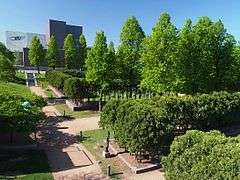Minneapolis Sculpture Garden
| Minneapolis Sculpture Garden | |
|---|---|
|
The Minneapolis Sculpture Garden and Walker Art Center | |
| Type | Sculpture park |
| Location | Minneapolis, Minnesota, United States |
| Coordinates | 44°58′13″N 93°17′20″W / 44.97028°N 93.28889°WCoordinates: 44°58′13″N 93°17′20″W / 44.97028°N 93.28889°W |
| Area | 11 acres (4.5 ha) |
| Created | 1988 |
| Operated by | Walker Art Center, Minneapolis Park and Recreation Board |
The Minneapolis Sculpture Garden is an 11-acre (4.5 ha) park in Minneapolis, Minnesota, in the United States.[1] It is located near the Walker Art Center, which operates it in coordination with the Minneapolis Park and Recreation Board. It is currently closed for renovation, and will reopen in June 2017 when the Walker and Sculpture Garden are unified as one 19-acre campus.[2] It is one of the largest urban sculpture gardens in the country, with 40 permanent art installations and several other temporary pieces that are moved in and out periodically.[3][4]
The park is in proximity to Loring Park and the Basilica of Saint Mary. The land was first purchased by the park board around the start of the 20th century, when it was known as "The Parade" because it had been used for military drills. It became known as the Armory Gardens after park superintendent Theodore Wirth created a formal design that included a U.S. National Guard armory (Kenwood Armory) for Spanish War Volunteers.
Working as a civic and cultural center, in 1913 a floral convention transformed the land into floral gardens, which it remained for the next 50 years. In 1934, six years after the Walker Art Gallery opened across the street, the Armory was demolished for its instability, and a new Armory built in downtown Minneapolis, turning the Armory Gardens over to the Minneapolis Park Board. Since 1908 the area of today's Sculpture Garden and land to the west had been used for sport recreation via mildly-improved playing fields and the 1950 construction of the original Parade Stadium (demolished in 1990).[5] In 1988, the Minneapolis Sculpture Garden opened, designed by Edward Larrabee Barnes and landscape architects Quinnel and Rothschild.[6] In 1992 the Garden was expanded, adding 3.5 acres (1.4 ha). Michael Van Valkenburgh and Associates, Inc. designed the northward extension to complement the original space with a more open area that features a walkway and the 300-foot-long (91 m) Alene Grossman Memorial Arbor.
The centerpiece of the garden is the Spoonbridge and Cherry (1985–1988) fountain designed by husband and wife Claes Oldenburg and Coosje van Bruggen.[7] The grounds also include the Cowles Conservatory, which has more flora and sculpture inside, such as Frank Gehry's Standing Glass Fish. A pedestrian bridge, the Irene Hixon Whitney Bridge (1987), designed by Siah Armajani now crosses I-94, connecting the sculpture garden to Loring Park.[8]
References
- ↑ Minneapolis Park & Recreation Board, "Minneapolis Sculpture Garden", Minneapolis Park & Recreation Board
- ↑ "Campus Renovation — Walker Art Center". www.walkerart.org. Retrieved 2016-05-06.
- ↑ Arts & Culture, "Minneapolis Sculpture Garden", Explore Minnesota
- ↑ Minnesota Public Gardens, "Minneapolis Sculpture Garden and Cowles Conservatory", Public Gardens of Minnesota
- ↑ http://www.minneapolisparks.org/documents/parks/Parks_Lakes_Trails_Much_More.pdf Minneapolis Park Board
- ↑ Sculpture Magazine Online, "Minneapolis Sculpture Garden", International Sculpture Center
- ↑ Claes Oldenburg & Coosje van Bruggen, "Chronology of Large-Scale Projects by Claes Oldenburg and Coosje van Bruggen", oldenburgvanbruggen.com
- ↑ Minneapolis Sculpture Garden, "A bridge that's a work of art", artsconnected
External links
| Wikimedia Commons has media related to Minneapolis Sculpture Garden. |
- Parade Stadium, Minneapolis in MNopedia, the Minnesota Encyclopedia
- Minneapolis Sculpture Garden
- Minneapolis Park & Recreation Board: Minneapolis Sculpture Garden
- Walker Art Center
